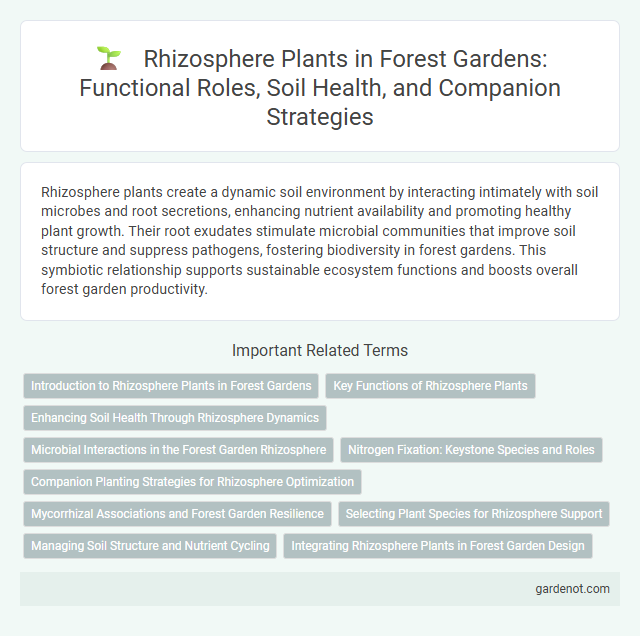Rhizosphere plants create a dynamic soil environment by interacting intimately with soil microbes and root secretions, enhancing nutrient availability and promoting healthy plant growth. Their root exudates stimulate microbial communities that improve soil structure and suppress pathogens, fostering biodiversity in forest gardens. This symbiotic relationship supports sustainable ecosystem functions and boosts overall forest garden productivity.
Introduction to Rhizosphere Plants in Forest Gardens
Rhizosphere plants in forest gardens play a crucial role in enhancing soil health and nutrient cycling by fostering beneficial microbial communities around their roots. These plants improve water retention, promote symbiotic relationships with mycorrhizal fungi, and contribute to natural pest control within diverse forest garden ecosystems. Integrating rhizosphere plants such as legumes and dynamic accumulators supports sustainable forest garden productivity and resilience.
Key Functions of Rhizosphere Plants
Rhizosphere plants play a critical role in nutrient cycling by enhancing microbial activity that breaks down organic matter, making nutrients more available to surrounding plants. They improve soil structure through root exudates that promote beneficial fungal and bacterial colonies, increasing soil aeration and water retention. These plants also act as natural biofilters, reducing pathogen load and supporting plant health in forest garden ecosystems.
Enhancing Soil Health Through Rhizosphere Dynamics
Rhizosphere plants play a crucial role in enhancing soil health by fostering complex interactions between roots, microbes, and soil particles, which boost nutrient cycling and organic matter decomposition. These plants promote beneficial microbial communities that improve soil structure and increase the availability of essential nutrients like nitrogen and phosphorus. Integrating rhizosphere plants in forest gardens supports sustainable ecosystem functions and enhances plant growth through natural soil enrichment.
Microbial Interactions in the Forest Garden Rhizosphere
Microbial interactions in the forest garden rhizosphere play a crucial role in nutrient cycling and plant health by fostering symbiotic relationships between roots and beneficial microbes such as mycorrhizal fungi and nitrogen-fixing bacteria. These microbes enhance soil structure, increase nutrient availability, and suppress soil-borne pathogens, promoting sustainable plant growth and resilience. Understanding the complex dynamics within the rhizosphere microbiome enables forest gardeners to optimize plant diversity and soil fertility naturally.
Nitrogen Fixation: Keystone Species and Roles
Rhizosphere plants such as legumes play a pivotal role in nitrogen fixation, converting atmospheric nitrogen into bioavailable forms that enhance soil fertility in forest gardens. Keystone species like acacias and clovers establish symbiotic relationships with nitrogen-fixing bacteria, significantly boosting nitrogen levels and supporting diverse plant communities. This natural nutrient cycling reduces the need for synthetic fertilizers, promoting sustainable forest garden ecosystems.
Companion Planting Strategies for Rhizosphere Optimization
Rhizosphere plant selection focuses on companion planting strategies that enhance nutrient cycling and improve microbial activity in the root zone. Integrating nitrogen-fixing species like clover or lupine next to deep-rooted trees boosts soil fertility and supports mycorrhizal fungi symbiosis. Optimizing root exudate interactions through diverse plant combinations increases carbon availability and pathogen resistance in forest garden ecosystems.
Mycorrhizal Associations and Forest Garden Resilience
Rhizosphere plants in forest gardens form crucial mycorrhizal associations that enhance nutrient uptake, particularly phosphorus, improving overall plant health and growth. These symbiotic fungi networks increase soil structure stability and microorganism diversity, contributing significantly to forest garden resilience against environmental stresses. By fostering robust mycorrhizal connections, forest gardens maintain sustainable productivity and ecological balance over time.
Selecting Plant Species for Rhizosphere Support
Selecting plant species with robust root systems enhances rhizosphere support by promoting beneficial microbial activity and nutrient cycling essential for forest garden health. Native perennial legumes, deep-rooted shrubs, and mycorrhizal-associated trees improve soil structure and increase nitrogen availability within the rhizosphere. Prioritizing species with complementary root architectures and exudate profiles maximizes microbial diversity, fostering resilient plant communities and sustainable forest garden ecosystems.
Managing Soil Structure and Nutrient Cycling
Rhizosphere plants enhance forest garden soil structure by promoting microbial activity and increasing organic matter through root exudates and decomposing roots. These plants improve nutrient cycling by facilitating the breakdown of organic material, releasing essential nutrients such as nitrogen, phosphorus, and potassium into the soil. Managing rhizosphere dynamics supports healthy root development and boosts soil fertility, leading to more resilient forest garden ecosystems.
Integrating Rhizosphere Plants in Forest Garden Design
Integrating rhizosphere plants in forest garden design enhances soil health by promoting beneficial microbial activity and nutrient cycling around plant roots. These plants, such as legumes and dynamic accumulators, improve soil structure and fertility by fixing nitrogen and extracting minerals. Strategic placement within forest gardens supports diverse plant communities and increases overall ecosystem resilience and productivity.
Rhizosphere plant Infographic

 gardenot.com
gardenot.com